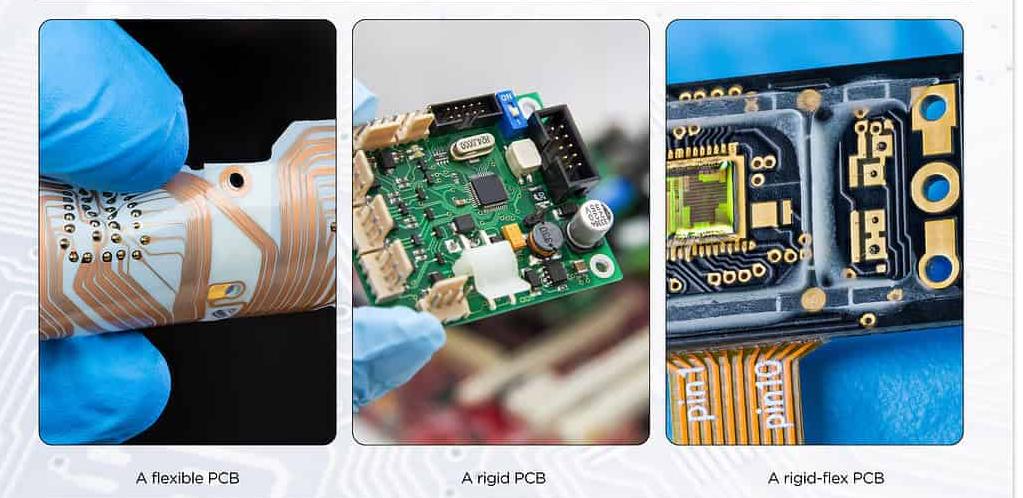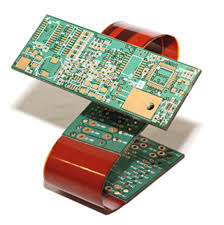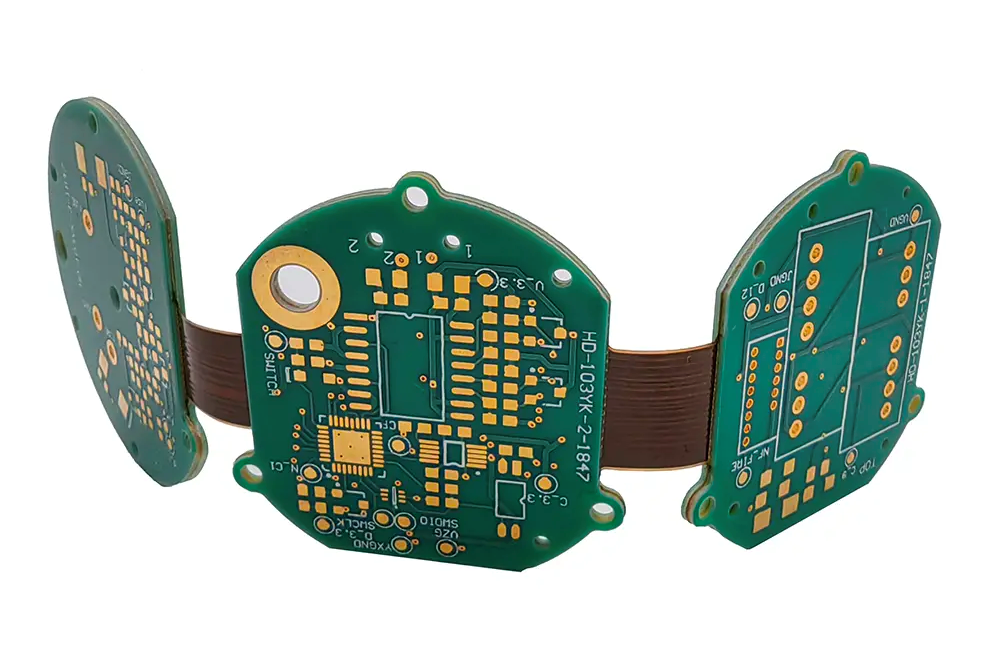If you're an electronic hobbyist wondering how to make your projects more compact, reliable, and innovative, rigid-flex PCBs might be the game-changer you need. Combining the stability of rigid boards with the adaptability of flexible circuits, rigid-flex PCBs offer unique advantages for hobby projects, especially in small electronics. In this beginner's guide from ALLPCB, we'll explore the key benefits of using rigid-flex PCBs, how they can elevate your DIY creations, and provide actionable tips on design and implementation for hobbyists.
What Are Rigid-Flex PCBs and Why Should Hobbyists Care?
Rigid-flex PCBs are hybrid circuit boards that integrate rigid and flexible sections into a single design. The rigid parts provide structural support for components, while the flexible sections allow the board to bend or fold, fitting into tight or irregular spaces. For electronic hobbyists working on compact gadgets or wearable tech, rigid-flex PCBs offer a powerful solution to space and durability challenges.
Unlike traditional rigid PCBs or standalone flexible circuits, rigid-flex designs reduce the need for connectors and cables, leading to fewer failure points and a sleeker build. This makes them ideal for hobby projects where space-saving and reliability are priorities, such as in small electronics like smartwatches, drones, or custom IoT devices.

Key Rigid-Flex PCB Advantages for Hobbyists
Let’s dive into the specific benefits of using rigid-flex PCBs in your hobby projects. These advantages can help you create more efficient, durable, and innovative designs, even as a beginner.
1. Space-Saving Design for Small Electronics
One of the standout rigid-flex PCB advantages is their ability to save space. For hobbyists designing small electronics, such as miniature robots or wearable sensors, rigid-flex PCBs allow you to fold or bend the board to fit into tight enclosures. This eliminates the bulk of traditional rigid boards and reduces the need for external wiring, which can take up valuable room.
For example, in a DIY smartwatch project, a rigid-flex PCB can wrap around the internal components, reducing the overall thickness by up to 50% compared to using multiple rigid boards connected by cables. This space efficiency lets hobbyists push the boundaries of compact design without sacrificing functionality.
2. Enhanced Durability and Reliability
Rigid-flex PCBs are built to last, making them a great choice for hobby projects that might face wear and tear. The integrated design minimizes the use of solder joints and connectors, which are common failure points in traditional setups. Fewer connections mean a lower risk of loose wires or broken contacts, improving the reliability of your device.
In numbers, some studies suggest that rigid-flex designs can reduce connection failures by up to 60% compared to assemblies with multiple rigid boards and cables. For hobbyists working on projects like portable gadgets or outdoor sensors, this durability ensures your creation withstands regular use or harsh conditions.
3. Reduced Weight for Portable Projects
Weight is a critical factor in many hobby projects, especially for drones or wearable tech. Rigid-flex PCBs are lighter than traditional multi-board setups because they eliminate the need for heavy connectors and wiring harnesses. This makes them perfect for rigid-flex PCB for small electronics where every gram counts.
For instance, in a quadcopter build, switching to a rigid-flex PCB could shave off several grams, improving flight time and efficiency. Hobbyists can achieve professional-grade results with lightweight, streamlined designs using this technology.
4. Simplified Assembly for DIY Enthusiasts
For those exploring DIY rigid-flex PCB projects, the simplified assembly process is a major plus. Since the rigid and flexible sections are part of a single board, you don’t need to spend time connecting separate components with wires or ribbon cables. This reduces assembly errors and saves time, especially for beginners who might struggle with complex soldering tasks.
This streamlined approach also lowers the chance of misalignment during assembly, ensuring your project works as intended from the start. It’s an accessible way for hobbyists to experiment with advanced designs without needing expert-level skills.

Applications of Rigid-Flex PCBs in Hobby Projects
Now that we’ve covered the benefits, let’s look at practical ways to use rigid-flex PCB for hobby projects. These examples show how this technology can inspire creativity and solve common challenges in DIY electronics.
1. Wearable Technology
Wearables like fitness trackers or custom LED bracelets require boards that conform to curved shapes while maintaining durability. Rigid-flex PCBs allow hobbyists to design circuits that bend around wrists or other body parts without breaking. The rigid sections can house microcontrollers or sensors, while the flexible parts ensure a snug fit.
2. Compact IoT Devices
Internet of Things (IoT) projects often involve small, interconnected devices like smart home sensors. Rigid-flex PCBs help hobbyists pack more functionality into tiny spaces, connecting components seamlessly without bulky wiring. This is especially useful for battery-powered projects where efficiency is key.
3. Robotics and Drones
In robotics, space and weight constraints are common hurdles. Rigid-flex PCBs enable hobbyists to create intricate control systems that fold into compact robot frames or drone bodies. The reduced weight also improves performance, allowing for longer operation times and better maneuverability.
How to Get Started with Rigid-Flex PCB Design as a Hobbyist
Designing a rigid-flex PCB might sound intimidating, but with the right tools and approach, even beginners can tackle it. Here’s a step-by-step guide to help you start your DIY rigid-flex PCB journey, focusing on accessible methods and resources.
Step 1: Understand Your Project Requirements
Before diving into design, define the needs of your project. Consider the size constraints, the number of components, and whether your device will be subjected to movement or bending. For instance, a wearable project might need multiple flex zones, while a static IoT sensor might only need one small flexible section.
Step 2: Choose the Right Design Software
Selecting user-friendly rigid-flex PCB design software for hobbyists is crucial. Look for tools that support both rigid and flexible layouts and offer intuitive interfaces for beginners. Many platforms provide free or low-cost versions with tutorials to help you learn the basics of layer stacking and bend radius planning.
Key features to look for include 3D visualization to preview how your board will fold, and design rule checks to avoid errors like excessive bending stress. These tools make it easier to create professional designs without advanced engineering knowledge.
Step 3: Plan the Rigid and Flexible Sections
In rigid-flex design, careful planning is essential to avoid damaging the flexible areas. Ensure the bend radius (the minimum radius the flex section can handle without cracking) is within safe limits—typically at least 10 times the thickness of the flex layer. For a 0.1mm thick flex layer, aim for a bend radius of 1mm or more.
Place critical components like microcontrollers or power regulators on the rigid sections for stability, and use the flexible parts for interconnections. This balances durability with adaptability in your design.
Step 4: Collaborate with a Trusted Manufacturer
Once your design is ready, partner with a reliable PCB fabrication service to bring your rigid-flex board to life. At ALLPCB, we specialize in supporting hobbyists with high-quality manufacturing and assembly services tailored to small-scale projects. Upload your design files, and our team will ensure precision in producing your rigid-flex PCB, even for prototypes.
Challenges to Consider in Rigid-Flex PCB Projects
While rigid-flex PCBs offer incredible benefits, they come with some challenges that hobbyists should be aware of before starting. Understanding these can help you avoid common pitfalls and ensure a successful build.
1. Higher Initial Costs
Compared to standard rigid PCBs, rigid-flex designs can be more expensive to prototype due to the specialized materials and manufacturing processes involved. For hobbyists on a tight budget, this might mean starting with simpler projects to justify the cost. However, the long-term durability and space savings often outweigh the upfront investment.
2. Design Complexity
Designing a rigid-flex PCB requires more planning than a traditional board. You’ll need to account for bend areas, material stress, and signal integrity across flexible sections. For beginners, this learning curve can be steep, but using the right software and starting with basic designs can ease the process.
3. Signal Integrity Considerations
In high-speed hobby projects, such as those involving RF signals or fast data transfer, signal integrity can be a concern. The flexible sections may introduce impedance mismatches if not designed properly. Aim for controlled impedance traces, keeping values consistent (e.g., 50 ohms for RF applications), and consult with your manufacturer for guidance on material selection to minimize signal loss.
Tips for Success with Rigid-Flex PCBs in Hobby Projects
To make the most of rigid-flex technology, follow these practical tips tailored for hobbyists:
- Start Small: Begin with a simple project to learn the basics of rigid-flex design before tackling complex builds.
- Test Thoroughly: Prototype and test your design to ensure the flexible sections withstand repeated bending without failure.
- Leverage Community Resources: Join online forums or communities for hobbyist electronics to share ideas and get advice on rigid-flex projects.
- Work with Experts: Partner with a manufacturer like ALLPCB that offers support for hobbyists, from design review to production.

Why Choose ALLPCB for Your Rigid-Flex Hobby Projects?
At ALLPCB, we’re committed to empowering electronic hobbyists with the tools and services needed to bring their ideas to life. Our expertise in rigid-flex PCB manufacturing ensures high-quality boards that meet the unique demands of small-scale and experimental projects. Whether you’re creating a one-off prototype or scaling up to a small batch, we provide fast turnaround times, competitive pricing, and dedicated support to guide you through the process.
Our online platform makes it easy to upload your designs, get instant quotes, and track your order from start to finish. Plus, our team is always ready to assist with design optimization to ensure your rigid-flex PCB performs flawlessly in your hobby project.
Conclusion: Elevate Your Hobby Projects with Rigid-Flex PCBs
Rigid-flex PCBs open up a world of possibilities for electronic hobbyists, offering unmatched space savings, durability, and design flexibility. Whether you’re building rigid-flex PCB for small electronics, experimenting with wearable tech, or creating lightweight drones, this technology can transform your DIY creations. By understanding the rigid-flex PCB advantages and following best practices for design and assembly, even beginners can achieve professional results.
Ready to take your hobby projects to the next level? Start exploring rigid-flex PCB for hobby projects with the support of ALLPCB. With the right tools, software, and manufacturing partner, your innovative ideas are just a design away from reality.



